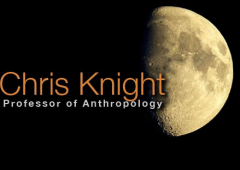Marek Kohn on the Knight/Power/Watts theory of human origins.
Ochre comes in shades of yellow, orange, red and brown; the core of it is the iron red of ferric oxide. Together with manganese dioxide, which is densely black, it offered Palaeolithic hominids a palette covering the spectrum of fire, from flame to charcoal.
Up to about 110,000 years ago, they only dabbled occasionally. Then, in southern Africa, ochre seems to have coloured their whole lives. It is present in ‘copious’ quantities at every cave and rock shelter that contains relics of occupation from this period. This was a monochrome explosion, based almost entirely on red ochre, and particularly upon strong reds, rather than orange or brown shades. The collectors of pigment made little or no use of the deposits of manganese ore and magnetite, a black iron oxide, which were available in some areas. According to Ian Watts of University College, London, who has made the study of prehistoric ochre his own, 99.5 per cent of all known African Middle Stone Age pigment is iron oxide, and 94 per cent contains a red streak.
Download As We Know It: Coming to Terms With an Evolved Mind [PDF 380KB]
